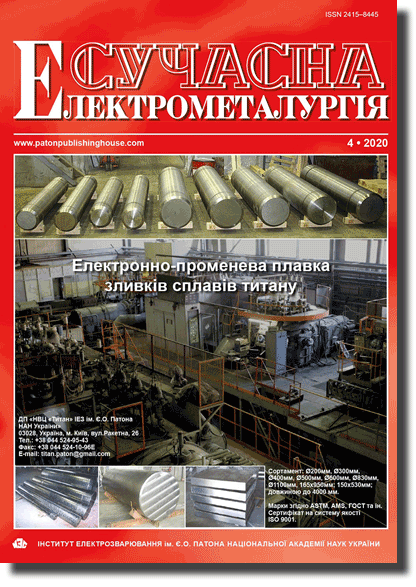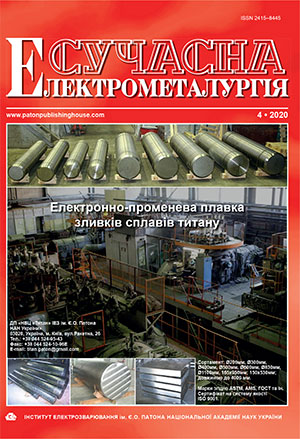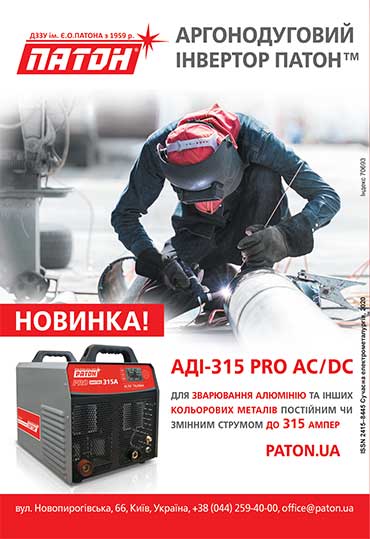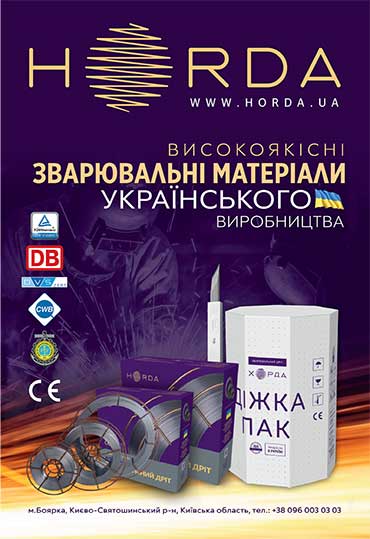| 2020 №04 (03) |
DOI of Article 10.37434/sem2020.04.04 |
2020 №04 (05) |
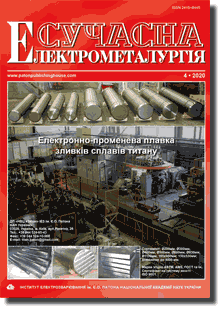
"Suchasna Elektrometallurgiya" (Electrometallurgy Today), 2020, #4, 23-27 pages
Metallurgical arc plasmatrons
V.O. Shapovalov
E.O. Paton Electric Welding Institute of the NAS of Ukraine. 11 Kazymyr Malevych Str., 03150, Kyiv, Ukraine. E-mail: office@paton.kiev.ua
Abstract
The problem of the service life of metallurgical plasmatrons is considered. It is shown that the area of the arc spot does not increase in proportion to the increase in the arc current. Increasing the current density in the arc spot leads to melting of the surface of the electrode on which the arc rests. To reduce the local current load on the electrode, it is proposed to make the electrode on which the arc rests split with controlled current load on each elementary electrode. The design of the split copper electrode assembly was implemented in the laboratory and has shown its efficiency. At some distance from the electrode, the elementary arcs are contracted into a single arc column. Ref. 13, Fig. 3.
Keywords: electric arc; near-electrode voltage drop; arc spots; plasmatron electrode
Received 30.11.2020
References
1. Lakomsky, V.I. (1974) Plasma-arc remelting. Kiev, Tekhnika [in Russian].2. Krivtsov, V.S., Plankovsky, S.I. (2005) Problems of creation of high performance high-current electric arc plasmatrons. Aerokosmicheskaya Tekhnika i Tekhnologiya, 7, 7-20 [in Russian].
3. Shapovalov, V.A., Tsykulenko, K.A., Sheiko, I.V., Kolesnichenko, V.I. (2010) Plasma metallurgy and service life of plasmatrons. Sovrem. Elektrometall., 4, 20-25 [in Russian].
4. Zamulo, N.I., Latash, Yu.V., Zabarilo, O.S. et al. (1989)Erosion resistance of electrodes of metallurgical plasmatrons. Problemy Spets. Elektrometallurgii, 2, 76-83 [in Russian].
5. Bogachenko, A.G., Mishchenko, D.D., Braginets, V.I. et al. (2016) Saving of electric power at the arc steel melting furnaces of direct current with graphitized cored electrodes. Sovrem. Elektrometall., 122(1), 58-64 [in Russian]. https://doi.org/10.15407/sem2016.01.09
6. Lakomsky, V.I. (2000) Plasma arc torch with an oxide cathode. The Paton Welding J., 12, 71-75.
7. Anshakov, A.S., Urbakh, E.K., Urbakh, A.E., Faleev, V.A. (2005) Study of thermochemical cathodes in arc plasmatrons. Teplofizika i Aeromekhanika, 12(4), 685-691 [in Russian].
8. Lakomskyi, V.Yo. (2006) Oxide cathode of welding arc. Fizyka i Khimiya Tverdogo Tila, 2, 326-330 [in Ukrainian].
9. Iowly, J.D. (1972) Four de fusion a electrode non consumable rotatroude. Vide, 161(27), 262 [in French].
10. Vaia, A., Akers, R. (1973) Durarc process for melting and casting titanium. Titanium Soc. and Technol., 1, 331-341. https://doi.org/10.1007/978-1-4757-1346-6_25
11. Shapovalov, V.A., Latash, Yu.V. (1999) Metallurgical plasmatrons. Problemy Spets. Elektrometallurgii, 4, 50-56 [in Russian].
12. Zhadkevich, M.L., Shapovalov, V.A., Melnik, G.A. et al. (2005) Arc heat sources with nonconsumable electrodes. Advances in Electrometallurgy, 4, 25-28.
13. Shapovalov, V.A., Melnik, G.A., Vislobokov, O.M. et al. (2006) Experimental investigation of erosion of copper water- cooled anodes. Ibid., 1, 14-16.
Advertising in this issue:
The cost of subscription/purchase order journals or individual articles
| Journal/Currency | Annual Set | 1 issue printed |
1 issue |
one article |
| TPWJ/USD | 384 $ | 32 $ | 26 $ | 13 $ |
| TPWJ/EUR | 348 € | 29 € | 24 € | 12 € |
| TPWJ/UAH | 7200 UAH | 600 UAH | 600 UAH | 280 UAH |
| AS/UAH | 1800 UAH | 300 UAH | 300 UAH | 150 UAH |
| AS/USD | 192 $ | 32 $ | 26 $ | 13 $ |
| AS/EUR | 180 € | 30 € | 25 € | 12 € |
| SEM/UAH | 1200 UAH | 300 UAH | 300 UAH | 150 UAH |
| SEM/USD | 128 $ | 32 $ | 26 $ | 13 $ |
| SEM/EUR | 120 € | 30 € | 25 € | 12 € |
| TDNK/UAH | 1200 UAH | 300 UAH | 300 UAH | 150 UAH |
| TDNK/USD | 128 $ | 32 $ | 26 $ | 13 $ |
| TDNK/EUR | 120 € | 30 € | 25 € | 15 € |
AS = «Automatic Welding» - 6 issues per year;
TPWJ = «PATON WELDING JOURNAL» - 12 issues per year;
SEM = «Electrometallurgy Today» - 4 issues per year;
TDNK = «Technical Diagnostics and Non-Destructive Testing» - 4 issues per year.





